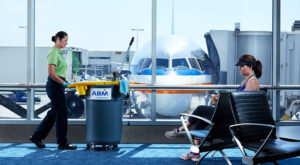Airports are bustling hubs of activity, teeming with travelers rushing to catch flights, families embarking on adventures, and business professionals jetting off to meetings. Amidst this constant motion, cleanliness and hygiene are paramount for ensuring a safe and comfortable environment for passengers and staff alike. Behind the scenes, a crucial yet often overlooked aspect of airport operations is the management of janitorial services. In this article, we delve into the intricate processes and systems that airports employ to maintain cleanliness and sanitation throughout their facilities.
The Importance of Janitorial Services in Airports
Airports are high-traffic environments where thousands of people pass through daily, making them susceptible to dirt, debris, and germs. The cleanliness of an airport not only impacts the overall passenger experience but also plays a vital role in public health and safety. Effective janitorial services are essential for mitigating health risks, preventing the spread of contagious illnesses, and upholding the airport’s reputation as a clean and welcoming space.
Staffing and Training
One of the fundamental aspects of managing janitorial services at airports is staffing. Airports typically employ a dedicated team of janitorial staff responsible for various tasks, including cleaning restrooms, emptying trash bins, mopping floors, and sanitizing high-touch surfaces such as handrails and seating areas. These staff members undergo rigorous training to ensure they adhere to strict cleanliness protocols and safety standards.
Training programs for airport janitorial staff often include modules on proper cleaning techniques, handling of cleaning chemicals, waste management procedures, and customer service skills. Additionally, janitorial staff may receive specialized training in areas such as biohazard cleanup and emergency response to deal with unforeseen situations effectively.
Cleaning Protocols and Schedules
To maintain cleanliness and hygiene throughout the airport, cleaning protocols and schedules are meticulously planned and executed. Different areas of the airport, such as terminals, gates, lounges, and baggage claim areas, have distinct cleaning requirements based on their usage patterns and foot traffic.
High-traffic areas are cleaned more frequently, sometimes multiple times per day, to ensure that surfaces remain free of contaminants. Restrooms are a particular focus area, with cleaning schedules often tailored to peak times of use. Additionally, janitorial staff are tasked with conducting regular inspections to identify areas in need of immediate attention and address any cleanliness issues promptly.
Utilization of Technology and Innovation
In recent years, airports have increasingly turned to technology and innovation to enhance their janitorial services and streamline operations. Automated cleaning equipment, such as robotic floor scrubbers and vacuum cleaners, can efficiently cover large areas and perform repetitive tasks, allowing human staff to focus on more specialized cleaning tasks.
Moreover, advancements in cleaning solutions and equipment have led to the adoption of environmentally friendly practices, such as the use of green cleaning products and water-saving technologies. These initiatives not only reduce the environmental impact of janitorial operations but also contribute to cost savings and sustainability efforts.
Collaboration with Third-Party Contractors
While many airports have in-house janitorial teams, some choose to outsource certain cleaning services to third-party contractors. These contractors specialize in various aspects of cleaning and maintenance, such as window cleaning, carpet shampooing, and exterior building maintenance.
Collaborating with third-party contractors allows airports to access specialized expertise and resources, particularly for tasks that require specialized equipment or skills. However, effective coordination and communication between airport management and contractors are crucial to ensure that cleaning standards are consistently met across the facility.
Emergency Preparedness and Response
In addition to routine cleaning tasks, airport janitorial staff play a vital role in emergency preparedness and response. In the event of spills, accidents, or other unforeseen incidents, janitorial teams are trained to respond quickly and effectively to mitigate risks and ensure the safety of passengers and staff.
Furthermore, janitorial staff may be called upon to assist during public health emergencies, such as outbreaks of infectious diseases. During such times, airports may implement enhanced cleaning and disinfection protocols to minimize the spread of illness and maintain a safe environment for travelers.
Conclusion
Behind the bustling terminals and bustling crowds, airport janitorial services quietly work to uphold cleanliness and hygiene standards that are essential for the well-being of passengers and staff. From staffing and training to cleaning protocols and emergency preparedness, a myriad of processes and systems are in place to ensure that airports remain clean, safe, and welcoming environments for all who pass through their gates. While their work may often go unnoticed, the dedication and professionalism of airport janitorial staff are integral to the smooth operation of these vital transportation hubs.


